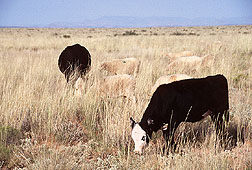This page has been archived and is being provided for reference purposes only. The page is no longer being updated, and therefore, links on the page may be invalid.
|
|
Non-Risky Business: New Technology Improves Ranch Management
By Laura McGinnisJanuary 24, 2006
Does the grass seem greener on the other side? That may change soon, thanks to new technology developed by the Agricultural Research Service (ARS) that predicts forage growth, allowing ranchers to make more-informed management decisions.
At the ARS Great Plains Systems Research Unit (GPSR) in Fort Collins, Colo., soil scientist Gale H. Dunn and range systems modeler Allan A. Andales are developing a database that will analyze historical and simulated data. The database will predict future forage growth and help ranchers decide how many animals to graze on native range.
The new database is based on GPFARM, a computer simulation model developed at GPSR to help central Plains farmers and ranchers make management decisions. GPFARM interprets data and predicts the outcomes of various management strategies. But its complexity intimidates many farmers and ranchers, decreasing its efficacy.
According to Dunn, ranchers, in particular, were missing the program’s benefits. So he submitted a proposal to the U.S. Department of Agriculture’s Risk Management Agency and received $570,000 to develop and deliver a database to help ranchers manage range and livestock production systems. The program, currently in the early developmental stage, will predict the effects of drought on range, forage and livestock production.
This new system, developed in cooperation with agricultural consulting firm Agren, Inc., will be simpler than GPFARM, according to Dunn. Instead of running a simulation model, the rancher will only need to submit simple questions to the database, which will be displayed on a basic spreadsheet. The program also will cover a wider ecological area than GPFARM.
Incorporating 50 years of historical climate and soil data from several ARS Great Plains research locations, the new database will be able to assess forage productivity of different locations during drought and wet years. With more-accurate predictions about forage growth potential, ranchers can adjust their management practices to reduce the impact of drought-related losses, minimizing the risks associated with soil and climate variability.
ARS is USDA’s chief scientific research agency.

